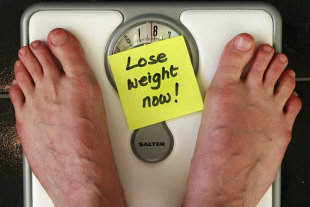One of the top reasons why people fail when they try to lose weight is because they gradually lose the motivation and momentum to do so. A weight loss plan can help prevent this. Weight loss plans are health plans that help you to lose weight. They should contain useful information such as goal setting, progress tracking and meal and work out planning.
1. Goal Setting
(photo: Alan Cleaver)
It is important to know what your goal is, which means the ideal amount of weight you want to lose. Many people have a goal but are clueless of how to start achieving that goal. Therefore, your weight loss plan should consist of small goals that will eventually help you achieve your ultimate goal. These little small goals are realistic and usually attainable within a short period of time. Hence, this keeps you motivated as your ultimate goal will not seem unrealistic with these little goals.
2. Progress Tracking
Setting smaller goals will also help you track the progress you have made in your weight loss journey. This helps you stay motivated, and you will be less likely to give up.
One of the ways to track your progress is by keeping a journal. Writing a journal allows you to reflect on your progress and record down the amount of food you have eaten. You will be less likely to get bored of your diet regimes as you are constantly reflecting and thinking about what you can add or remove from your plan. Journals can also motivate you since you are able to see how much progress you have made over time. Research shows that keeping a food journal can help you lose more weight and keep it off.
3. Meal and work out planning
After setting your goals, you should concentrate on achieving your goals.
For meal planning, you can make weekly shopping lists or lists of foods that you want to eat each week. Coming up with meal plans allows you to calculate your intake of calories, carbohydrates, proteins and fat. This helps ensure you will be confident about the foods you choose to eat, and it can also prevent you from falling back into your old eating habits.
The importance of an active lifestyle

(photo: sean dreilinger)
Apart from having a healthy diet, another essential component to losing weight is an active lifestyle. We all know that we have to exercise, but sometimes we just cannot find the time to do it. If this is the case for you, try making a work out plan.
Schedule a particular time slot of your day for exercising. If that seems too rigid, you can also schedule a certain duration of exercising per day. For example, if you plan to exercise one hour per day, you have to exercise for at least one hour per day, no matter what. It can be at any time, so you could even split it up into four 15-minute increments. Fifteen minutes at once seems much less daunting than a full hour.
If you know beforehand that you have a busy workday ahead and will return home late, you can perhaps wake up an hour earlier than usual on that particular day to exercise. Doing this will take you one step closer to your ideal weight.
Sticking to your weight loss plan
A weight loss plan allows you to have a clear idea of what your goal is and how to go about achieving it. Overall, once you’ve made a plan, you should stick with it, but don’t be afraid to do a little extra if you have the opportunity to.
If you cannot reach your goals in the amount of time you have given yourself, do not fret. Keep in mind that a little amount of progress is better than no progress at all. Furthermore, a plan also allows you to know if you are making the amount of progress you are aiming for. If you are not, figure out what went wrong. Is it the food that you’ve been eating? Is it the amount of exercise? Did you set goals that are too extreme? You might also want to consult a nutritionist for advice.
Have you created your own weight loss plan? What are the factors that you considered when trying to come up with your weight loss plan?
Edited by Registered Dietitian Arielle Kamps, M.S., R.D, L.D. Via HealthMatters.sg, a Singapore Health and Fitness blog that aims to help you lose weight, keep fit, and live healthy. Click here to get our free guide “Eat Your Way to Health – Secrets of a Healthy Diet”.
Ref: http://sg.news.yahoo.com/create-weight-loss-plan-081729718.html
1. Goal Setting
(photo: Alan Cleaver)
It is important to know what your goal is, which means the ideal amount of weight you want to lose. Many people have a goal but are clueless of how to start achieving that goal. Therefore, your weight loss plan should consist of small goals that will eventually help you achieve your ultimate goal. These little small goals are realistic and usually attainable within a short period of time. Hence, this keeps you motivated as your ultimate goal will not seem unrealistic with these little goals.
2. Progress Tracking
Setting smaller goals will also help you track the progress you have made in your weight loss journey. This helps you stay motivated, and you will be less likely to give up.
One of the ways to track your progress is by keeping a journal. Writing a journal allows you to reflect on your progress and record down the amount of food you have eaten. You will be less likely to get bored of your diet regimes as you are constantly reflecting and thinking about what you can add or remove from your plan. Journals can also motivate you since you are able to see how much progress you have made over time. Research shows that keeping a food journal can help you lose more weight and keep it off.
3. Meal and work out planning
After setting your goals, you should concentrate on achieving your goals.
For meal planning, you can make weekly shopping lists or lists of foods that you want to eat each week. Coming up with meal plans allows you to calculate your intake of calories, carbohydrates, proteins and fat. This helps ensure you will be confident about the foods you choose to eat, and it can also prevent you from falling back into your old eating habits.
The importance of an active lifestyle

(photo: sean dreilinger)
Apart from having a healthy diet, another essential component to losing weight is an active lifestyle. We all know that we have to exercise, but sometimes we just cannot find the time to do it. If this is the case for you, try making a work out plan.
Schedule a particular time slot of your day for exercising. If that seems too rigid, you can also schedule a certain duration of exercising per day. For example, if you plan to exercise one hour per day, you have to exercise for at least one hour per day, no matter what. It can be at any time, so you could even split it up into four 15-minute increments. Fifteen minutes at once seems much less daunting than a full hour.
If you know beforehand that you have a busy workday ahead and will return home late, you can perhaps wake up an hour earlier than usual on that particular day to exercise. Doing this will take you one step closer to your ideal weight.
Sticking to your weight loss plan
A weight loss plan allows you to have a clear idea of what your goal is and how to go about achieving it. Overall, once you’ve made a plan, you should stick with it, but don’t be afraid to do a little extra if you have the opportunity to.
If you cannot reach your goals in the amount of time you have given yourself, do not fret. Keep in mind that a little amount of progress is better than no progress at all. Furthermore, a plan also allows you to know if you are making the amount of progress you are aiming for. If you are not, figure out what went wrong. Is it the food that you’ve been eating? Is it the amount of exercise? Did you set goals that are too extreme? You might also want to consult a nutritionist for advice.
Have you created your own weight loss plan? What are the factors that you considered when trying to come up with your weight loss plan?
Edited by Registered Dietitian Arielle Kamps, M.S., R.D, L.D. Via HealthMatters.sg, a Singapore Health and Fitness blog that aims to help you lose weight, keep fit, and live healthy. Click here to get our free guide “Eat Your Way to Health – Secrets of a Healthy Diet”.
Ref: http://sg.news.yahoo.com/create-weight-loss-plan-081729718.html

No comments:
Post a Comment